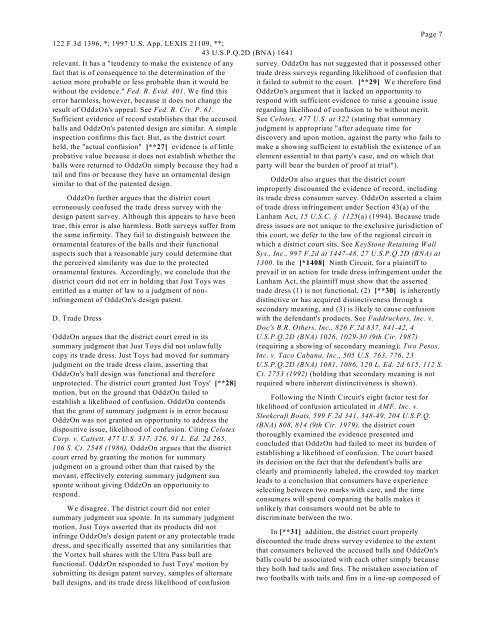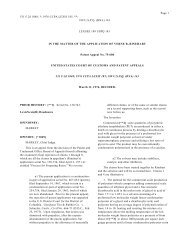ODDZON PRODUCTS, INC., Plaintiff-Appellant, v. JUST TOYS, INC.
ODDZON PRODUCTS, INC., Plaintiff-Appellant, v. JUST TOYS, INC.
ODDZON PRODUCTS, INC., Plaintiff-Appellant, v. JUST TOYS, INC.
You also want an ePaper? Increase the reach of your titles
YUMPU automatically turns print PDFs into web optimized ePapers that Google loves.
122 F.3d 1396, *; 1997 U.S. App. LEXIS 21109, **;43 U.S.P.Q.2D (BNA) 1641relevant. It has a "tendency to make the existence of anyfact that is of consequence to the determination of theaction more probable or less probable than it would bewithout the evidence." Fed. R. Evid. 401. We find thiserror harmless, however, because it does not change theresult of OddzOn's appeal. See Fed. R. Civ. P. 61.Sufficient evidence of record establishes that the accusedballs and OddzOn's patented design are similar. A simpleinspection confirms this fact. But, as the district courtheld, the "actual confusion" [**27] evidence is of littleprobative value because it does not establish whether theballs were returned to OddzOn simply because they had atail and fins or because they have an ornamental designsimilar to that of the patented design.OddzOn further argues that the district courterroneously confused the trade dress survey with thedesign patent survey. Although this appears to have beentrue, this error is also harmless. Both surveys suffer fromthe same infirmity. They fail to distinguish between theornamental features of the balls and their functionalaspects such that a reasonable jury could determine thatthe perceived similarity was due to the protectedornamental features. Accordingly, we conclude that thedistrict court did not err in holding that Just Toys wasentitled as a matter of law to a judgment of noninfringementof OddzOn's design patent.D. Trade DressOddzOn argues that the district court erred in itssummary judgment that Just Toys did not unlawfullycopy its trade dress. Just Toys had moved for summaryjudgment on the trade dress claim, asserting thatOddzOn's ball design was functional and thereforeunprotected. The district court granted Just Toys' [**28]motion, but on the ground that OddzOn failed toestablish a likelihood of confusion. OddzOn contendsthat the grant of summary judgment is in error becauseOddzOn was not granted an opportunity to address thedispositive issue, likelihood of confusion. Citing CelotexCorp. v. Catrett, 477 U.S. 317, 326, 91 L. Ed. 2d 265,106 S. Ct. 2548 (1986), OddzOn argues that the districtcourt erred by granting the motion for summaryjudgment on a ground other than that raised by themovant, effectively entering summary judgment suasponte without giving OddzOn an opportunity torespond.We disagree. The district court did not entersummary judgment sua sponte. In its summary judgmentmotion, Just Toys asserted that its products did notinfringe OddzOn's design patent or any protectable tradedress, and specifically asserted that any similarities thatthe Vortex ball shares with the Ultra Pass ball arefunctional. OddzOn responded to Just Toys' motion bysubmitting its design patent survey, samples of alternateball designs, and its trade dress likelihood of confusionPage 7survey. OddzOn has not suggested that it possessed othertrade dress surveys regarding likelihood of confusion thatit failed to submit to the court. [**29] We therefore findOddzOn's argument that it lacked an opportunity torespond with sufficient evidence to raise a genuine issueregarding likelihood of confusion to be without merit.See Celotex, 477 U.S. at 322 (stating that summaryjudgment is appropriate "after adequate time fordiscovery and upon motion, against the party who fails tomake a showing sufficient to establish the existence of anelement essential to that party's case, and on which thatparty will bear the burden of proof at trial").OddzOn also argues that the district courtimproperly discounted the evidence of record, includingits trade dress consumer survey. OddzOn asserted a claimof trade dress infringement under Section 43(a) of theLanham Act, 15 U.S.C. § 1125(a) (1994). Because tradedress issues are not unique to the exclusive jurisdiction ofthis court, we defer to the law of the regional circuit inwhich a district court sits. See KeyStone Retaining WallSys., Inc., 997 F.2d at 1447-48, 27 U.S.P.Q.2D (BNA) at1300. In the [*1408] Ninth Circuit, for a plaintiff toprevail in an action for trade dress infringement under theLanham Act, the plaintiff must show that the assertedtrade dress (1) is not functional, (2) [**30] is inherentlydistinctive or has acquired distinctiveness through asecondary meaning, and (3) is likely to cause confusionwith the defendant's products. See Fuddruckers, Inc. v.Doc's B.R. Others, Inc., 826 F.2d 837, 841-42, 4U.S.P.Q.2D (BNA) 1026, 1029-30 (9th Cir. 1987)(requiring a showing of secondary meaning); Two Pesos,Inc. v. Taco Cabana, Inc., 505 U.S. 763, 776, 23U.S.P.Q.2D (BNA) 1081, 1086, 120 L. Ed. 2d 615, 112 S.Ct. 2753 (1992) (holding that secondary meaning is notrequired where inherent distinctiveness is shown).Following the Ninth Circuit's eight factor test forlikelihood of confusion articulated in AMF, Inc. v.Sleekcraft Boats, 599 F.2d 341, 348-49, 204 U.S.P.Q.(BNA) 808, 814 (9th Cir. 1979), the district courtthoroughly examined the evidence presented andconcluded that OddzOn had failed to meet its burden ofestablishing a likelihood of confusion. The court basedits decision on the fact that the defendant's balls areclearly and prominently labeled, the crowded toy marketleads to a conclusion that consumers have experienceselecting between two marks with care, and the timeconsumers will spend comparing the balls makes itunlikely that consumers would not be able todiscriminate between the two.In [**31] addition, the district court properlydiscounted the trade dress survey evidence to the extentthat consumers believed the accused balls and OddzOn'sballs could be associated with each other simply becausethey both had tails and fins. The mistaken association oftwo footballs with tails and fins in a line-up composed of





